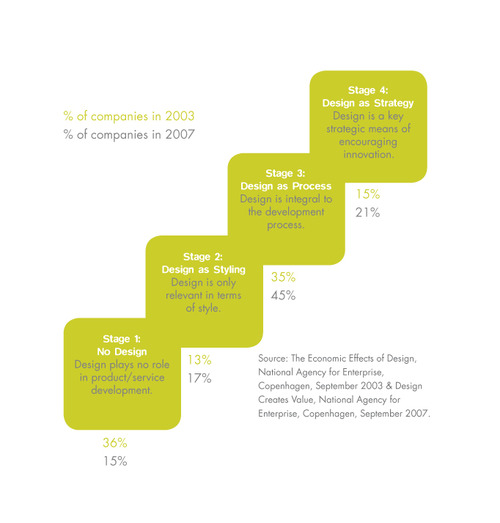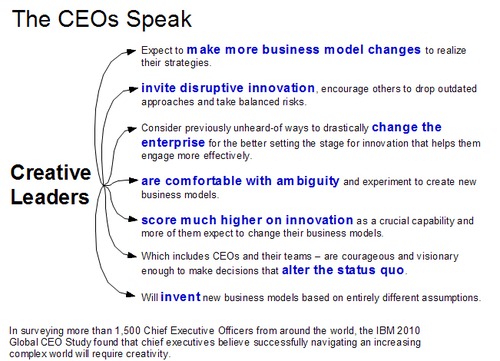Benefit N° eight: strategic design, design as a competitive advantage
When people talked about innovation in the '90s, they really meant technology. When people talk about innovation in this decade, they really mean design.
source: Bruce Nussbaum, BusinessWeek
Innovation mainly occurs on the levels of processes, products and services, brands and business models. The goal of innovation is to achieve a competitive advantage. The problem of our times is that those advantages won't last long and innovative processes, products and business models can easily be copied or slightly changed as IT tools, tools and services are available to everybody, especially to the emerging markets. Speed has dramatically increased, innovation cycles have become shorter and shorter.
In our fast changing world, with its increasing hunger for innovation, an organization using only analytical management practices to enhance efficiency like ERP, CRM and six sigma won't succeed in the market in the long run. Leaders are aware of that missing out on innovation bears a high risk to success. The success of brands and businesses is highly dependent on customer satisfaction, on how their products, services and brands are experienced by the customer. Design is the way to build this bridge to the customer, to discover his needs and wants. Strategic design is a competitive advantage.
The steps from not using design at all to design as strategy are visualized in the four steps of the Design Ladder - a ladder which, through the Danish Design Centre, has become an international qualifications framework for the development of strategic design:
The higher the step on the ladder, the more strategic the design implementation within a company. The more design is integrated into the business strategy and drives all business activities to better satisfy user needs, the more likely a company is to experience growth in demand for products and services.

source: seeplatform.eu
Design Management aligns product, advertising, marketing, communication and customer service through consistently applied strategic design, so the company can build an even more powerful branded message. Design Management is closely aligned with design thinking.
According to the Design Management Institute, the four powers of design include:
- Design as differentiator
- Design as integrator (a resource that improves new product development processes (building consensus in teams using visualization skills); design as a process that favors user-oriented innovation models and fuzzy-front-end project management)
- Design as transformer (a resource for creating new business opportunities; for improving the company's ability to cope with change)
- Design as good business (a source of increased sales, greater market share, better ROI, design as a resource for society at large)
source Brigitte Borja de Mozota, DMI Review, Design Management Institute
Let's go one step further: how much value does the most powerful strategic design have, if the innovation is not embraced and supported at the CEO level? If this brilliant and promising innovative concept can't survive due to politics and short-therm decision making?
Of no value, at all.
INNOVATION = INVENTION + IMPLEMENTATION
An idea is just an idea, but which ideas to follow, which vision to pursue are top management decisions. Design leadership is key to innovation.
Innovation can't be outsourced to an innovative agency bringing in fresh spirit and colorful ideas or dedicated only to the R&D department - it has to be deeply integrated in the DNA of the organization and drive decision making. It takes a leader who nurtures a culture of innovation, who generates the right conditions for creativity and innovation.
'Metaphorically, leaders can provide the heat and light and moisture and nutrients for a creative culture to blossom and grow. They can focus the best efforts of talented individuals to build innovative, successful groups.'
source: David Kelley, Creative Confidence, innovation leadership
A study by IBM 2010 with over 1.500 CEOs across 60 nations and 33 industries said that creativity is now the most important leadership quality for success in business.

source: IBM 2010
Our changing world asks for leaders who are willing to take creative risks, who welcome ambiguity, who are courageous and visionary, who have the ability to 'connect the dots', nurture a creative culture and envision the big picture: sounds very much like our world needs design skills.
Promising times to be a designer. Time to take on responsibility and get into the 'game', or it will be played without us!